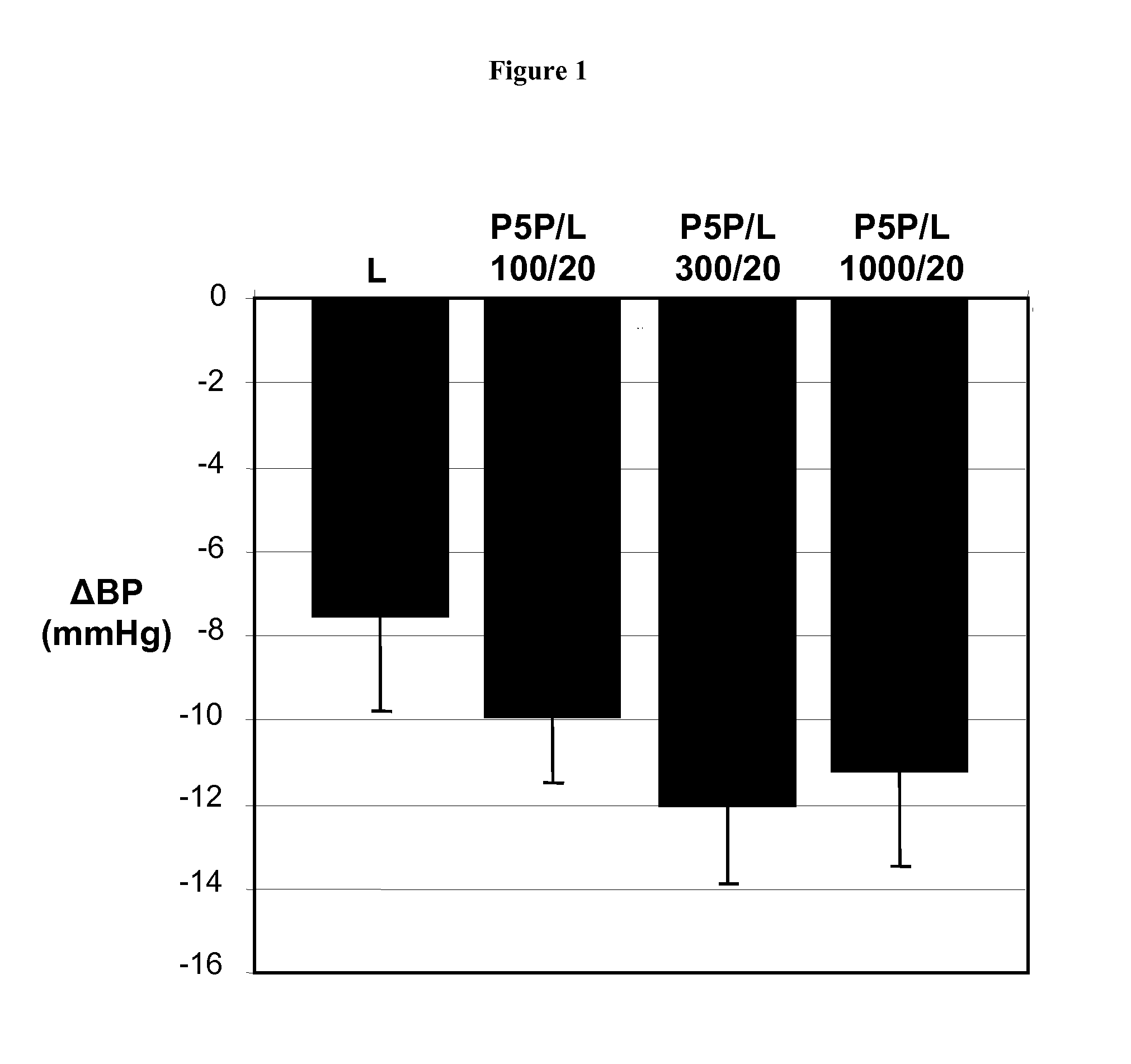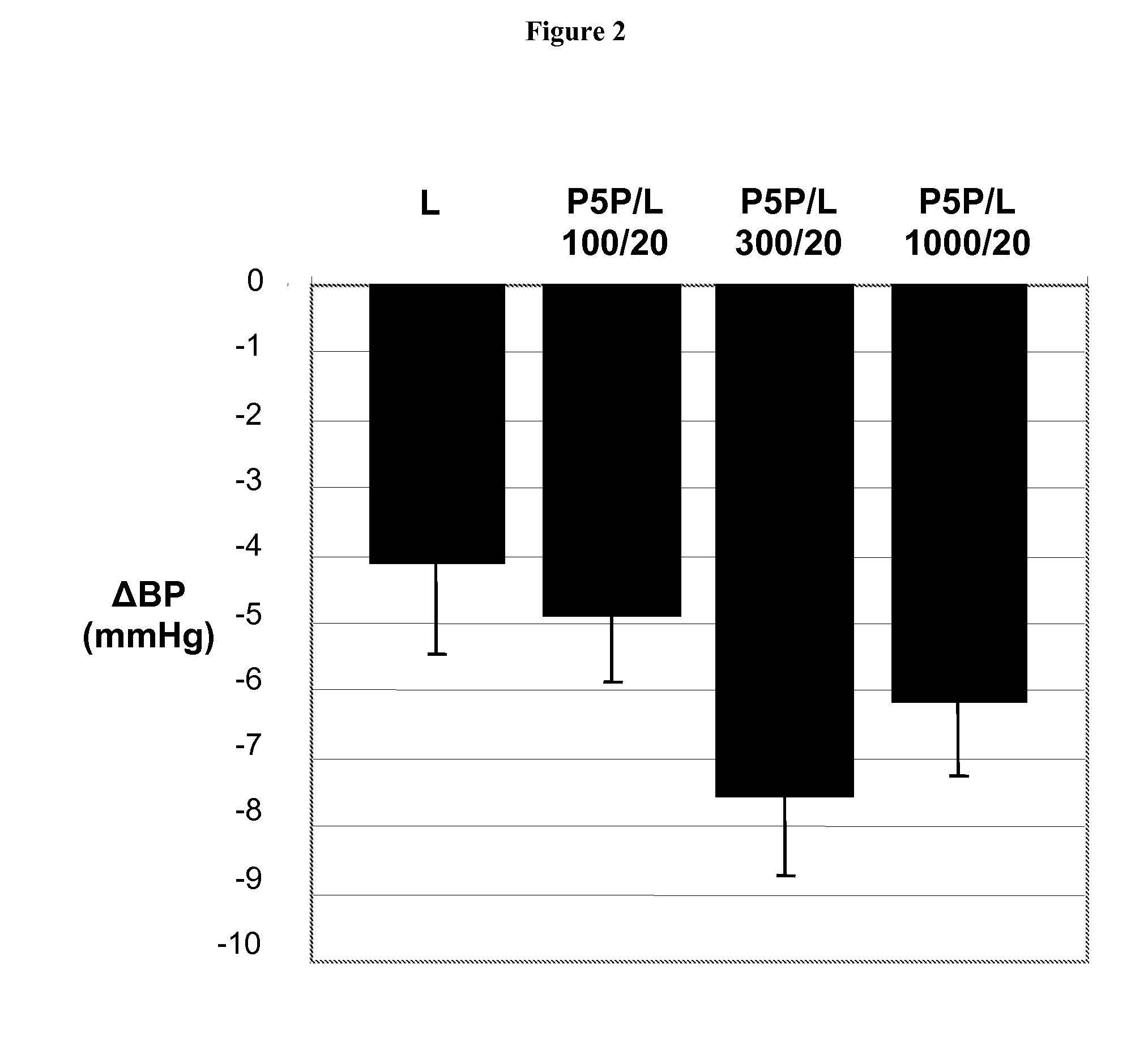Combination Therapies Employing Ace Inhibitors and Uses Thereof for the Treatment of Diabetic Disorders
a technology of angiotensin converting enzyme and combination therapy, which is applied in the direction of biocide, cardiovascular disorder, drug composition, etc., can solve the problems of increasing the risk of both macrovascular and microvascular complications, hypertension, etc., and achieves the effects of improving metabolic function, improving metabolic function, and increasing insulin sensitivity
- Summary
- Abstract
- Description
- Claims
- Application Information
AI Technical Summary
Benefits of technology
Problems solved by technology
Method used
Image
Examples
example 1
Animal Toxicology Studies of Pyridoxal-5′-Phosphate (P5P)
[0122]As a prelude to human clinical studies, the toxicology of P5P was assessed by conventional means using two animal species, rats and dogs. Acute toxicity evaluations indicated no significant toxicity at doses up to 5 g / kg in the rat and 100 mg / kg in dogs. Rats administered P5P orally at 50 mg / kg for 14 days showed no signs of toxicity. Long term studies, 13-week oral toxicity in dogs, and 26-week oral toxicity in rats, were completed. In the 13-week dog study, no drug related toxicities were observed at both 10 and 25 mg / kg. With the exception of anorexia and body weight loss in the high dose 50-60 mg / kg dose group, all other findings were considered to be mild to moderate. During the recovery phase, the 50-60 mg / kg group animals recovered almost completely. No findings of toxicological significance were observed at any dose level (50, 100 / 175, 175 / 325 mg / kg) in the 26-week rat toxicity study, other than reversible reduct...
example 2
Phase I Tolerance Study of Pyridoxal-5′-Phosphate (P5P)
[0123]In a Phase I single dose tolerance study, conducted in accordance with generally accepted clinical practice standards, groups of six patients were tested at 15 mg / kg, 30 mg / kg, and 60 mg / kg (enteric coated tablets). No adverse events were reported in the 15 mg / kg dose group. One subject in the 30 mg / kg dose group experienced events of dizziness and sleepiness. Four subjects in the 60 mg / kg dose group reported a total of 10 adverse events including diarrhea, bradycardia, bubbly stomach, flatulence, and headaches that were mild in severity. During the Phase I multi-dose tolerance study, five of six patients treated with 30 mg / kg P5P tolerated the medication well, while one patient withdrew from the trial due to vomiting and diarrhea. An evaluation of multidose tolerance at 60 mg / kg resulted in all 6 treated patients experiencing a variety of mild gastrointestinal symptoms considered to be probably related to study drug. Phar...
example 3
Phase II Clinical Study: Effectiveness of Pyridoxal-5′-Phosphate (P5P) in Diabetic Patients
[0124]In a phase II clinical study, conducted in accordance with generally accepted clinical practice standards, diabetic hypertensive patients were treated with P5P. Glucose control was determined by measuring glycated hemoglobin levels (HbAlc). Four weeks prior to treatment, patients ceased all antihypertensive therapy. Following the washout period, baseline HbAlc measurements were taken. Patients were than treated with 250 mg, 500 mg, and 750 mg of P5P for two weeks at each dosage. P5P treatment was then discontinued for 4 weeks. Following the washout period, HbAlc measurements were taken. Patients who presented with clinically elevated HbAlc at the start of the treatment and who completed the treatment with P5P were found to show a 5.4% reduction in HbAlc levels as compared to baseline.
PUM
| Property | Measurement | Unit |
|---|---|---|
| pressure | aaaaa | aaaaa |
| temperature | aaaaa | aaaaa |
| systolic blood pressure | aaaaa | aaaaa |
Abstract
Description
Claims
Application Information
 Login to View More
Login to View More - R&D
- Intellectual Property
- Life Sciences
- Materials
- Tech Scout
- Unparalleled Data Quality
- Higher Quality Content
- 60% Fewer Hallucinations
Browse by: Latest US Patents, China's latest patents, Technical Efficacy Thesaurus, Application Domain, Technology Topic, Popular Technical Reports.
© 2025 PatSnap. All rights reserved.Legal|Privacy policy|Modern Slavery Act Transparency Statement|Sitemap|About US| Contact US: help@patsnap.com



